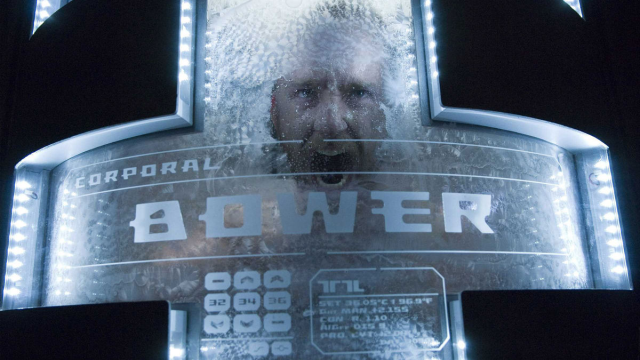It was while rewatching 2009 space horror flick Pandorum over the weekend that I realised it’s essentially a Souls movie in disguise, released just a month before Demon’s Souls arrived in the United States.
No, wait, don’t go! I can explain!
In my mind, there are three key elements to a Dark Souls story: a protagonist exploring the remnants of a society long after it’s collapsed, antagonists that lost themselves sometime during that collapse, and a heavy emphasis on environmental storytelling and lore. Pandorum has all of those, plus a side character that feels like an exact copy of Patches, the conniving NPC that acts as one of the biggest unifying details between Demon’s Souls, the Dark Souls series, and Bloodborne. Let’s get into it.

Pandorum follows Payton (Dennis Quaid) and Bower (Ben Foster) after they awaken from hypersleep aboard the interstellar spaceship Elysium, which as far as they know is in the middle of a 123-year process of transporting 60,000 colonists to an Earth-like planet named Tanis. A prolonged stint in suspended animation has left them with scattered memories of their mission. What they do know is that they’re trapped in the room where they awakened, cut off from the bridge and the flight crew they’re supposed to relieve.
Much of the movie focuses on Bower as he explores the ship, trying to piece together why he’s there and what his purpose is. It’s clear from the outset that things haven’t gone well, mostly thanks to an opening scene where the captain is informed that Earth, overpopulated and desperate, has disappeared after an apparent nuclear war. But even after Bower escapes the hypersleep room, the ship seems more like an alien tomb rather than a vessel that was supposed to save humanity.
The Elysium, like Boletaria, Lordran, Drangleic, Lothric, and Yharnam after it, serves almost as a secondary character in the story of Pandorum. Its shadowy hallways billow with steam as Bower explores their depths, creaking and groaning against the hollow space outside. Add to that the random reactor malfunctions, which sees the ship’s various electronics and engineering suddenly spring to life before again settling into a low-power mode, and it’s like the Elysium is a living creature doing its best to contend with the organisms inside of it.
Bower eventually learns that the vessel has been overrun by a species of vicious cannibals that subsist on the Elysium’s crew. The power fluctuations mean that they are constantly supplied with delirious pilots and engineers as they unceremoniously leave hypersleep. Marauders rampage through the halls of the spaceship with crude, makeshift weapons, evoking images of the hunting parties that antagonize the player in the opening hours of Bloodborne. The cannibals even look a little like Hollows, basic enemies from the rest of the Souls series.
After Bower meets Nadia and Manh, two fellow survivors, it’s slowly explained that the Elysium has been adrift in space for an indeterminate amount of time following an unspecified catastrophe. They travel through the ship, doing their best to avoid the monsters as Bower remembers more and more about his life before entering hypersleep. Corpses, seemingly strung up and devoured by the cannibals, litter the passageways. Scorch marks on the walls and floors indicate some sort of struggle. It isn’t until our group runs into the manic Leland, a cook who has made a home for himself in an inconspicuous part of the ship, that the full story is revealed through crude artwork scrawled into the metal tomb.
Upon learning that the Earth was gone, a member of the flight crew succumbed to a futuristic malady known as Pandorum, which causes spacefaring humans to go mad with paranoia. This crewmember — who we learn near the end of the movie is Payton — killed the rest of the flight crew and commandeered the ship, turning it into his own little kingdom. But Payton got bored, and he returned to hypersleep. The ensuing years saw the rest of the crew adapt to survive the confines of the Elysium, spurred on by an enzyme that was supposed to get them ready for living on Tanis. These colonists eventually, over generations, evolved into the cannibals that now hunt the remnants of humanity
Oh yeah, and Leland, who is initially friendly, drugs the main characters and plans to eat them before Bower explains that he can fix the reactor. Definitely sounds like a Patches move to me.
But more than any plot points, Pandorum’s similarities to From Software’s oft-cited canon is all about feeling. While not as good a movie as I remember from my post-high-school years, it absolutely nails the foreboding mystery of Dark Souls and Bloodborne. Sure, you’re not in direct control of the characters, but the ways in which they sift through the rubble of a society long-decayed, trying to make sense of the situation with the smallest clues, is very much like how Souls fans pore over item descriptions for scraps of lore.
In a review from September 2009, Orlando Sentinel writer Roger Moore described Pandorum as “the best movie based on a video game to not actually have a video game to base it on ever.” Demon’s Souls would arrive in North America one month later to usher in the now-famous From Software formula. If Mr. Moore had only waited, he would have had the perfect video game analogue to Pandorum’s decrepit environments and meaningfully obtuse narrative.

Leave a Reply